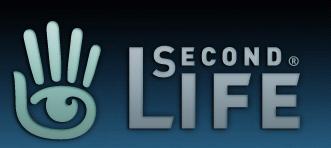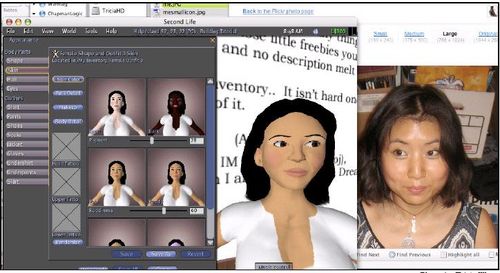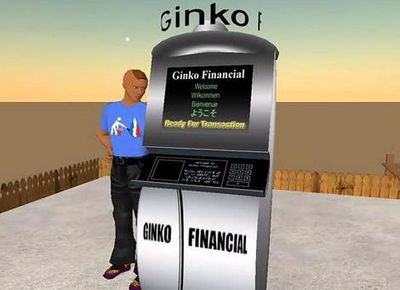T18 Group 3 - Stepping Into the World of Virtual Reality
Contents
Topic
Focusing on the banking aspect of a 3D virtual world, Second Life.
Team Members
Agnes Li, Wael Nasser, Steven Lee
Statement
Some banks have made the transition from the Real World (RL) to a three-dimensional realm called Second Life (SL)—a virtual world where millions of dollars are spent. The rationale behind these transitions ranges from attracting press coverage to brand engagement with potential clients. So, the main question here is: is the banking system reliable in the (SL)?
Argument
Although Second Life’s banking system may seem like a way to make some extra money in the real-world, some banks offer annual interest rates of 40% or more. These types of cases are almost always too good to be true. The problem with Second Life banks is that they are not regulated, unlike the thousands of people who help manage banks in the real world. This, along with many other recorded bank thefts, has created a great sense of unreliability.
What Is Second Life?
Brief Overview
Second Life, created by Linden Labs, is not just another video game, but instead, it is a virtual world; a community where users can take on a whole new identity online through creating their own characters, called ‘avatars’. Not only can you interact with other online players through your avatar, but you can also buy properties, start businesses, join clubs, attend classes or create objects. In short, Second Life is very similar to Sims, the main difference being that you are able to earn real-world money through the conversion of the “Linden Dollar” to US dollars. As Second Life puts it, Second Life is “an online society shaped entirely by its residents. Participants join a world full of people, activity, and fun – a constantly changing shared reality where they can choose their own goals – travel and explore, claim and build on virtual land, make friends and socialize, or vie for status and wealth”.
Brief History
Second Life was launched in 2003 by a company called Linden Reseach Inc (more commonly known as Linden Labs). Not until recently, has it become popular with the public. The virtual community has now reached approximately 13 million accounts (number recorded near the end of March 2008).
Banking Systems
How do they work?
In Second Life, your avatar is able to take on jobs just as you would in the real world. However, in this virtual world, the money you earn from your job is referred to as “Linden dollars”. These Linden dollars can be exchanged to US dollars through a system called LindeX, the most recent exchange rate (as of January 2007) being $268 Linden dollars to $1 US. A survey taken in Fall 2006, shows that over 3,000 residents make an excess of 20 thousand US Dollars per year running businesses in Second Life. Most of these residents sell objects they’ve created to other residents who want the items. One Second Life resident landed a Business Week cover story for earning a three-figure income (in real-world dollars) selling virtual real estate.
Unregulated Banks
An announcement posted by Linden Labs says the following, "The so-called banks are not operated, overseen or insured by Linden Lab, nor can we predict which will fail or when. And Linden Lab isn't, and can't start acting as, a banking regulator." They also wrote that these banks have brought many risks to Second Life which leads to their decision of banning the banks.
"As of January 22, 2008, it will be prohibited to offer interest of any direct return on an investment (whether in Linden dollars or other currency) from any object, such as an ATM, located in Second Life, without proof of an applicable government registration statement or financial institution charter,"
Video / Sound Links
References
Agnes:
1-http://www.bilawchuk.com/mark
2-http://electronics.howstuffworks.com/virtual-reality8.htm
4-http://www.bmj.com/cgi/content/full/323/7318/912
5-http://newestechnology.blogspot.com/2007/09/advantages-disadvantages-and.html
6-http://www.axistive.com/what-is-a-head-tracking-mouse.html
7-http://www.wearable.ethz.ch/education/sada/summer07_head
8-http://www.a-s-l.com/press/press2005.htm
9-http://www.sony.net/Products/vpt/tech/index.html
Steven:
1-http://www.inference.phy.cam.ac.uk/dasher/History.html
2-http://www.sciencedirect.com/science?_ob=ArticleURL&_udi=B6V08-4JN2J1J- 1&_user=1067480&_rdoc=1&_fmt=&_orig=search&_sort=d&view=c&_acct=C000051253&_version=1&_urlVersion=0&_userid=1067480&md5=f889b7a fc3d8ea6d1e75473e721a219b
4-http://www.cs.tufts.edu/~jacob/papers/ecem.pdf
5-www.cs.cmu.edu/~johnny/projects/wii/
6-www.tekgear.com/index.cfm?pageID=90&prodid=462§ion=83
7-http://archive.ncsa.uiuc.edu/Cyberia/VETopLevels/VR.History.html
8-https://www.enactivenetwork.org/download.php?id=100
9-http://www.skycontrol.net/flight-simulators-hardware-software/bring-head-tracking-to-your-headset-with-the-new-trackclippro- tm-from-naturalpoint/
10-http://archive.ncsa.uiuc.edu/Cyberia/VETopLevels/VR.History.html
Wael:
1-http://ieeexplore.ieee.org/iel5/11159/35819/01699653.pdf?tp=&isnumber=&arnumber=1699653
2-http://www.cs.unc.edu/~tracker/
3-http://www.ndigital.com/research/apps-eyetracking.php
4-http://www.robots.ox.ac.uk/~jamie/pdf/paterson03.pdf
5-http://www.answers.com/topic/head-mounted-display?cat=technology
6-http://about.eyetap.org/library/weekly/aa012301a.shtml
7-http://psyc.queensu.ca/~frostlab/vr.html
8-http://www.mechdyne.com/interaction.htm
9-http://www.cse.yorku.ca/~percept/papers/Hogue-A_vision-based_head_tracking_system.pdf
10-http://courses.ece.ubc.ca/518/previous/hit2006/papers/ChanLaiZhang.pdf


